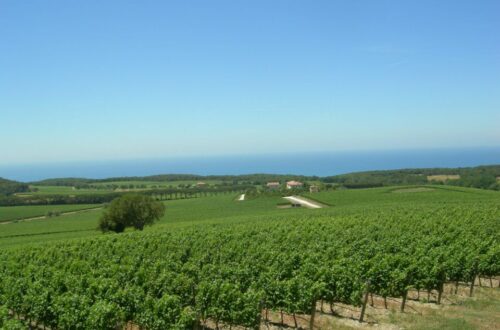Table of Contents
What is Biferno DOC? – Quick Facts
Biferno DOC is a versatile wine appellation in Molise, southern Italy, officially recognized in 1983. Named after the Biferno River, it produces elegant whites (Trebbiano-based), fresh rosati, and structured reds based on Montepulciano with Aglianico. The zone stretches across 42 municipalities in Campobasso province, an area where rolling hills, river valleys, and Adriatic breezes shape the wines’ character.
Essential Details:
- Established: 1983 DOC status
- Region: Molise, Campobasso province
- Styles: Bianco, Rosato, Rosso, Superiore, Riserva
- White Blend: 65–70% Trebbiano Toscano, plus Bombino or Malvasia
- Red Blend: 70–80% Montepulciano + 10–20% Aglianico, plus Sangiovese
- Altitude: Vineyards up to 600m (whites) and 500m (reds)
- Aging: Riserva wines require minimum 3 years aging, including 6 months in bottle
History and Origins
Although officially codified in the 1980s, Biferno’s winemaking roots trace back centuries, influenced by Samnite tribes, Roman colonists, and later, Benedictine monks who cultivated vines along the fertile valleys of the Biferno River. The region’s relative isolation preserved traditional viticulture, making Molise a rare pocket of authenticity in the Italian wine map.
Where It’s Made: Geography & Terroir
Biferno DOC lies in central Molise, a small region tucked between Abruzzo, Puglia, and Campania. The vineyards cascade from hillsides down to the Adriatic coast, with soils ranging from clay-limestone to gravelly riverbeds. The Apennine mountains provide cooling winds, while the sea ensures mild winters and sun-drenched summers — an ideal recipe for vibrant whites and structured reds.
The Grape (or Blend)
- Bianco: Trebbiano Toscano dominates (65–70%), yielding crisp, citrusy wines often blended with Malvasia for floral lift.
- Rosso & Riserva: Montepulciano (70–80%) provides deep color and plum-like fruit, while Aglianico (10–20%) adds backbone, spice, and aging potential. Some blends include a touch of Sangiovese.
- Rosato: Made from the same grapes, delivering bright cherry fruit and Mediterranean herbs.
Winemaking & DOC Regulations
- Bianco: Min. 65% Trebbiano Toscano, up to 30% Bombino or Malvasia
- Rosso/Rosato: 70–80% Montepulciano, 10–20% Aglianico, up to 20% Sangiovese
- Rosso Superiore: Higher alcohol (min. 12.5%) and greater concentration
- Riserva: Minimum 3 years aging (including 6 months in bottle) before release
Why Biferno DOC is Italy’s Best-Kept Wine Secret
While Tuscany and Piedmont dominate the headlines, Molise’s Biferno DOC offers world-class quality without the price tag.
Hidden Gem Advantages:
- Value: Premium bottles often cost €12–30, compared to €50+ from Tuscany
- Authenticity: Family-run wineries still dominate production
- Uniqueness: Montepulciano–Aglianico blend rarely found elsewhere
- Discovery Factor: Few outside Italy know Biferno, making it a perfect “wine insider” find
Best Biferno DOC Producers & Wineries to Try
- Di Majo Norante – Benchmark producer, organic methods, internationally exported
- Cantine Salvatore – Traditional winemaking with modern polish
- Campi Valerio – Historic estate reviving Molise terroir
- Cieri & Borgo di Colloredo – Excellent expressions of Rosso and Riserva
- Tenute Martarosa – Rising star with fresh takes on classic blends
Biferno DOC vs Other Southern Italian Wines
- Versus Abruzzo: Both rely on Montepulciano, but Molise adds Aglianico for structure.
- Versus Campania: Less volcanic intensity than Taurasi, but more approachable early.
- Versus Puglia: Fresher and less heavy than many Negroamaro or Primitivo wines.
Key Facts at a Glance
| Style | Grapes | Aging | Profile |
| Bianco | 65–70% Trebbiano Toscano | Drink young | Crisp, citrus, floral |
| Rosato | Montepulciano + Aglianico | Drink young | Cherry, herbs, savory |
| Rosso | 70–80% Montepulciano + Aglianico | 2 years | Plum, spice, tannins |
| Riserva | Same blend | 3 years | Deep, structured, long-lived |
Tasting Notes
- Bianco: Crisp apple, lemon zest, almond, saline minerality
- Rosso: Dark cherry, plum, licorice, earthy spice
- Riserva: Tobacco, leather, dried herbs, robust tannins, age-worthy
Serving & Pairing
- Bianco: Serve chilled (8–10°C) with seafood, fried anchovies, or mozzarella di bufala.
- Rosso: Slightly cooler than room temp (16–18°C), perfect with lamb, pasta alla molisana, or aged pecorino.
- Riserva: Decant before serving with wild boar, braised short ribs, or truffle dishes.
Price Guide: Is Biferno DOC Worth Buying?
Most bottles range €12–30 / $15–35, delivering exceptional value compared to Tuscany or Piedmont. Riserva wines may cost slightly more but remain affordable relative to their complexity.
Molise Wine Tourism: Visiting Biferno Vineyards
Molise is one of Italy’s least-explored regions, offering authentic rural hospitality. Visitors can explore Di Majo Norante’s 18th-century cellars, hike near the Matese mountains, and enjoy Adriatic views paired with rustic cucina molisana.
FAQ on Biferno DOC
Q: What does Biferno DOC mean?
It’s named after the Biferno River in Molise.
Q: Is Biferno DOC red or white?
Both — Trebbiano-based whites, Montepulciano–Aglianico reds, plus rosé and Riserva.
Q: How long can Biferno Riserva age?
10–15 years for top producers.
Q: Where can I buy Biferno DOC?
Available via specialist Italian wine importers, online shops, and select European supermarkets.
Fun Facts & Cultural Notes
- Molise is Italy’s second-smallest region, often overlooked on the wine map.
- Locals joke, “Molise non esiste” (“Molise doesn’t exist”) — but its wines prove otherwise.
- The blend of Montepulciano and Aglianico is unique to Molise, rarely replicated elsewhere.
Where to Buy Biferno DOC Wine
Look for bottles online via Wine.com, Vivino, or Eataly, or in Italian specialty shops. For travel shoppers, Di Majo Norante is widely available in the US and UK.
Call to Action
Ready to discover Italy’s best-kept wine secret? 🍷
👉 Join the Drink Italian community newsletter for insider guides to hidden Italian regions, tasting notes, and curated wine picks.


